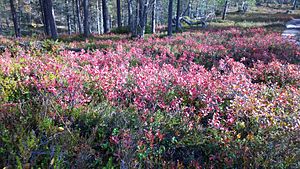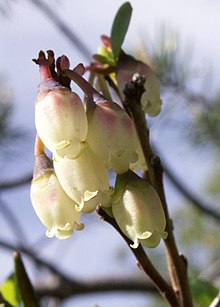Bogberry
| Bogberry | ||||||||||||
|---|---|---|---|---|---|---|---|---|---|---|---|---|

Bogberry ( Vaccinium uliginosum ), leaves in autumn colors |
||||||||||||
| Systematics | ||||||||||||
|
||||||||||||
| Scientific name | ||||||||||||
| Vaccinium uliginosum | ||||||||||||
| L. |
The bog berry ( Vaccinium uliginosum ), also blackberry , bogberry or cloudberry , is a shrub belonging to the blueberry genus .
description

Vegetative characteristics
The bog bilberry grows as a small shrub . The leaves are blue-green on top, gray-green and oval on the underside.
Generative characteristics
The flowering period extends from May to June. The relatively small flowers are whitish to pink in color. The berries are similar to those of the bilberry or blueberry , but are frosted, significantly larger than these and roughly egg-shaped. They ripen in late summer, are blue on the outside, but have light "pulp" and light-colored juice on the inside, in contrast to blueberries, which have blue "pulp" and also have blue juice.
The number of chromosomes is 2n = 24 or 48, depending on the subspecies.
Toxicity
Also known as cranberries , red bilberries , stone berries or swamp blueberries known berries of bilberry may psychotropic substances included whose identity could not be determined after the consumption of fruits poisoning were occasionally -. Such as noise-like excitation, vomiting, dilated pupils and dizziness - observed. Intoxication is only possible after consuming large amounts. The parasitic hose fungus Monilinia megalospora (formerly Sclerotina megalospora ) is probably responsible for this .
In terms of folk etymology, this name of bogberry is related to the state of intoxication observed.
The leaves contain the active ingredients hyperoside , ursolic acid , alpha-amyrin , friedelin , oleanolic acid , (+) - catechin and organic acids .
Occurrence
The bogus berries grow in forest bogs and raised bogs with moist, peaty soil . It is widespread in rainy western Scandinavia , where it partly displaces the blueberry . In central and southern European mountains you can sometimes find them at altitudes of 3000 meters. It is a Vaccinio-Piceetea class character, but also occurs in societies of the Ocycocco-Sphagnetea class or the Genistion association.
Systematics
The first description of Vaccinium uliginosum was made by Carl Linnaeus . The specific epithet uliginosum refers to the place of growth and means "swamp-loving".
There are two subspecies in Europe:
- Common bog bilberry ( Vaccinium uliginosum L. subsp. Uliginosum ): Its flower stalks are 3–10 mm long. It grows upright and becomes 20–80 cm high. It is the predominant clan in the lower areas. Their chromosome number is 2n = 48.
- Small-leaved bog bilberry ( Vaccinium uliginosum subsp. Pubescens (Wormsk. Ex Hornem.) Hornem. Syn .: Vaccinium gaultherioides Bigelow ): Their flower stalks are only 1–3 mm long. It grows prostrate-ascending and is only 5–20 cm high. It occurs more in higher altitudes and here in societies of the Loiseleurio-Vaccinion association. The number of chromosomes is 2n = 24. In the Allgäu Alps , it rises on the Kreuzeck -Rücken in Bavaria to an altitude of up to 2300 meters.
use
The berries are picked less than the blueberries , but have a similar taste and can be processed for the same purposes, i.e. they can be used to make jam , puree , liqueur or fruit wine .
The bogberry was used in folk medicine for diarrhea and bladder problems. In eastern Siberia , the bush is used for tanning , while the berries are used to make a strong brandy.
Origin of name
The name bogberry is derived from the Latin ruscus for scrub, and other associated shrubs are also named similarly.
literature
- Manfred A. Fischer, Wolfgang Adler, Karl Oswald: Excursion flora for Austria, Liechtenstein and South Tyrol . 2nd, improved and enlarged edition. State of Upper Austria, Biology Center of the Upper Austrian State Museums, Linz 2005, ISBN 3-85474-140-5 .
- Bruno P. Kremer: Shrub trees. Recognize and determine (= Steinbach's natural guide). Mosaik, Munich 2002, ISBN 3-576-11478-5 .
- Lutz Roth, Max Daunderer , Kurt Kormann: Poison Plants - Plant Poisons. Occurrence, effect, therapy, allergic and phototoxic reactions. With a special section about poisonous animals. 6th, revised edition, special edition. Nikol, Hamburg 2012, ISBN 978-3-86820-009-6 .
Individual evidence
- ↑ a b c d Erich Oberdorfer : Plant-sociological excursion flora for Germany and neighboring areas . With the collaboration of Angelika Schwabe and Theo Müller. 8th, heavily revised and expanded edition. Eugen Ulmer, Stuttgart (Hohenheim) 2001, ISBN 3-8001-3131-5 , pp. 732 .
- ↑ a b c Entry on cranberry. In: Römpp Online . Georg Thieme Verlag, accessed on June 13, 2013.
- ↑ a b Science Online Lexica: Entry on "Vaccinium species" in the Lexicon of Medicinal Plants and Drugs , accessed on June 13, 2013.
- ↑ Erhard Dörr, Wolfgang Lippert : Flora of the Allgäu and its surroundings . Volume 2, IHW-Verlag, Eching near Munich, 2004, ISBN 3-930167-61-1 .
Web links
- Bogberry. In: FloraWeb.de.
- Bogberry . In: BiolFlor, the database of biological-ecological characteristics of the flora of Germany.
- Vaccinium uliginosum aggr. In: Info Flora , the national data and information center for Swiss flora . Retrieved January 14, 2016.
- Distribution in the northern hemisphere according to Eric Hultén
- Thomas Meyer: Data sheet with identification key and photos at Flora-de: Flora von Deutschland (old name of the website: Flowers in Swabia )
- Vaccinium uliginosum at Plants For A Future




